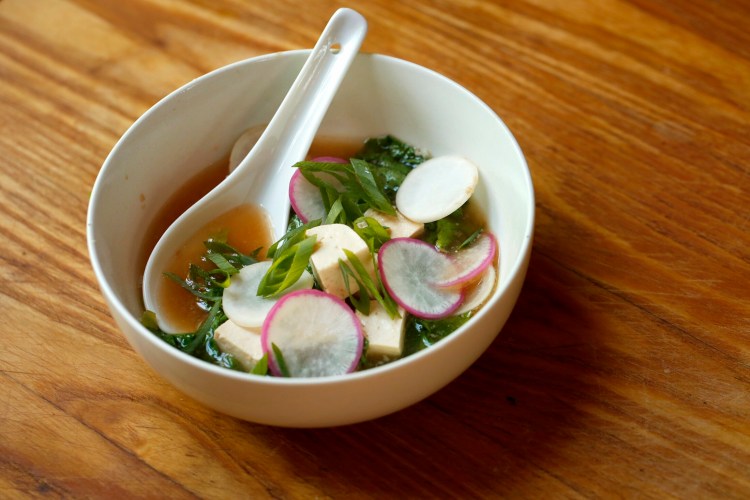Radishes, when I was growing up, were nothing special. They were uniformly trimmed, red on the outside, white on the inside, with a spongy crunch and a hint of pepper. They were sold in small plastic bags, and when you ripped the bags open, a few radishes inevitably fell out and bounced around the kitchen floor. It’s a food memory that allowed me to pass on radishes for much of my adult life.
Until it became more commonplace to sell radishes with their tuft of greens still intact, that is. Maybe the draw stems from a notion that I’m getting more for my money, two vegetables for the price of one. Or maybe from a sense that the radishes are fresher – the bright, crisp leaves proof of their vitality. Regardless, I now buy them by the armfuls: bunches of red, purple and pink garden radishes and their cousins, small, creamy white hakurei turnips, both veggies with greens attached.

Radishes with their tops. Both parts of the vegetable – roots and leaves – are edible. Ben McCanna/Staff Photographer
To keep both the radish and turnips firm and the leaves from wilting, the two must be separated from each other soon after you bring them home. These bunches are often held together by a rubber band wrapped around their stems an inch or two above the bulbs. Cut the tops off the bunch immediately above the rubber band.
Store the root vegetables unwashed in a sealed glass or plastic container in crisper drawer of the refrigerator until you’re ready to use them, either raw or roasted; the latter brings out their sweetness. If roasting them, do so with the truncated stems intact as they are edible and add a rustic flare to a dish of roasted vegetables.
Pick through the tops, removing any leaves that are wilted or yellowing. Radish leaves have tender ribs so can be left whole. The ribs of turnip leaves can be thicker, tougher, you’ll need to chop them into smaller pieces before eating or cooking them.
Both radish and turnip leaves can be gritty so you may need to rinse them twice to remove the sand. Then use a salad spinner to remove most of the water from the leaves, wrap them in a damp towel and store them with the bulbs. I’ve not had much luck keeping the leaves crisp for longer than three or four days, so use them early and often in your weekly salad (be it green, grain, potato or egg), light summer soup and sautéed greens rotation, as you would young spinach or baby kale.
Both radish and turnip leaves have a spicier bite than most lettuces you’ll find in a spring mix. Shredding the raw leaves before adding them to the bowl helps disperse the strong flavor throughout the salad. These leaves also add an earthy, peppery flavor to chopped greens condiments like chimichurri sauce for grilled meat and vegetables and pureed greens sauces like pesto used to dress pasta and flavor sandwiches. Don’t add radish and turnip leaves to soups or sautés until the end of the cooking process as they need only a little heat to wilt. Overcooking them zaps them of their flavor, which would be both a shame and a waste.
Ginger-Garlic Miso Soup With Radish Tops and Bottoms
This recipe is adapted from one published in Lindsay-Jean Hard’s “Cooking with Scraps: Turn Your Peels, Cores, Rinds, and Stems into Delicious Meals.” It’s quick, easy, and if you use Go-en Fermented Foods white miso (from Whitefield) and Heiwa Tofu (from Rockland), can be a wholly locally sourced vegetarian meal.
Serves 4
1 small bunch of radishes or hakurei turnips with greens intact
3 scallions
2 tablespoons neutral-flavored vegetable oil
2 tablespoons finely minced fresh ginger
2 garlic cloves, finely minced
1/4 cup white miso paste
6 cups vegetable broth
6 ounces firm tofu, cut into ½-inch cubes
Separate leaves from roots of the radishes or turnips. Wash both separately. Slice the roots thinly and set them aside. Remove any longer stems from the leaves, mince them and set them aside. Tear the leaves into bite-sized pieces.
Use a pair of kitchen shears to cut dark green parts of the scallions into thin rings and set aside. Finely mince the light green and white parts of the scallions.
Warm the oil in a medium-sized pot over medium heat. Add the ginger, garlic, chopped greens stems and minced scallion parts. Sauté, stirring occasionally, until the white parts of the scallions are nearly translucent and the turnip stems are tender, about 5 minutes.
Place the miso in a small bowl. Add the vegetable broth to the pot on the stove and raise the heat to medium-high. Once the broth is very hot, but not boiling, ladle about 1 cup of it into the miso and whisk to make a slurry. Return the mixture to the pot along with half of the green parts of the scallions, and the shredded greens and tofu. Stir gently to incorporate.
Turn off the heat and let the soup stand for a few minutes to wilt the greens. Spoon into bowls, garnish with sliced radishes and remaining scallions. Serve immediately.
Copy the Story LinkSend questions/comments to the editors.



Success. Please wait for the page to reload. If the page does not reload within 5 seconds, please refresh the page.
Enter your email and password to access comments.
Hi, to comment on stories you must . This profile is in addition to your subscription and website login.
Already have a commenting profile? .
Invalid username/password.
Please check your email to confirm and complete your registration.
Only subscribers are eligible to post comments. Please subscribe or login first for digital access. Here’s why.
Use the form below to reset your password. When you've submitted your account email, we will send an email with a reset code.